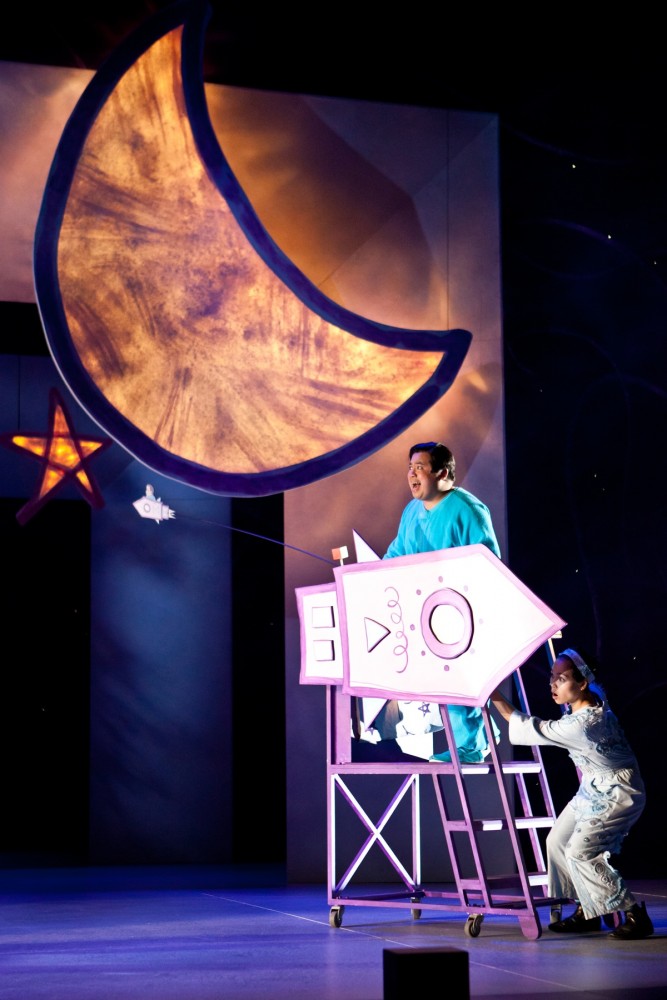What: Harold and the Purple Crayon
Where: Children’s Theatre Company, 2400 S. 3rd Ave.
When: Feb. 23-26
Cost: $10-43.50
The first objective of children’s entertainment is, believe it or not, to entertain children. This is something that used to be mutually exclusive to entertaining adults. Now Pixar’s long run of one great movie after another, along with Spike Jonze’s intellectually heavy 2009 film adaptation of “Where the Wild Things Are,” have either raised the bar for children’s entertainment or even blurred the line between what is for kids and what is for the rest of us.
Within this landscape, the Children’s Theatre Company brings a play/musical adaptation of Crockett Johnson’s classic children’s book, “Harold and the Purple Crayon.” The production is the result of a partnership between members of the Children’s Theatre Company and the Seattle Children’s Theatre, which wrote and developed the show. It has been running since Jan. 17 and has one weekend left.
In the book and show, a young boy named Harold finds a crayon that brings to life anything he draws. He builds and explores a world around him at once.
Though this production does flirt with emotional and interesting themes, like the aforementioned films, “Harold and the Purple Crayon” does not quite transcend the label of children’s entertainment the way they do. Before the show even started, the audience was asked to, “Please silence your cellphones or mobile devices. Don’t make us ask twices.” Clearly entertaining the kids was the first priority, which is understandable since children made up most of the audience.
The problem is that some moments do match the greatness of the book. When Harold, played by Don Darryl Rivera, draws his first two lines on the ground to make a road and begins to walk down it, there is a real sense of wonder. It is moving when Harold draws and climbs a hill at the same time. The audience’s hopes rise with Harold’s as he reaches for the moon, and fall as he does after he fails to do so.
These scenes succeed for several reasons. The music that accompanies the best portions of the play is excellent. Earthy and acoustic, verging on ambient at times, it felt gentle and innocent, matching Harold’s demeanor and spirit. And this background music transitioned smoothly into simple, well-written songs, performed nicely by Rivera, Khanh Doan and Caety Sagoian.
Also, these moments involved actual, physical embodiments of Harold’s drawings. The hill slowly entered from the side of the stage as Rivera climbed it. One of the funniest scenes involved a giant dragon puppet, operated by Doan and Sagoian. Even the simplest things, the first two lines Harold draws on the ground to make the road, felt magical because they had come off of his crayon and were now living on stage.
Unfortunately, only some of the show worked this way. Much of the action was projected on the walls around and a screen behind the stage. Having the live actors interact with these images feels innovative in theory, but the show often relied too heavily on it. At one point, a giant crab attacks during Harold’s underwater adventures. A large puppet crab arm poked out from the side of the stage several times, attempting to grab Harold, which was immediately more fun to watch. But it would quickly retreat and the projections remained. Rivera ran and danced around the stage, breathing heavily from fear, but most of the action was up on the screen.
Watching moments like these, of which there were plenty, felt like watching cartoons because that’s pretty much what they were. This is, on some level, acceptable. The children in the audience responded extremely well to most of the projected scenes. But after seeing the show capture very real warmth and awe inspired by the book, these scenes were disappointing.
“Simpler is better” was generally the rule for methods of bringing the drawings to life, and the same is true for the show’s plot developments. After Harold’s sweet and earnest attempt to reach the moon, he builds a rocket ship. When he arrives in space he meets two aliens who assist him in a kind of fun but oddly out of place funk jam.
Even the mouse and porcupine, who appear in the original books, are speaking French for some reason. Additions and changes to the original text like this are obviously necessary to lengthen the show, but too often they felt contrary to the spirit of the book that, again, the show had proved it was very capable of capturing.
None of this mattered to the kids, obviously. Their reactions ranged from impressive attentiveness to unbridled excitement and joy. During a lull in the middle of one of the songs, a girl near the front row, incapable of waiting for the end, yelled, “Yay!” For about half of the show, children and adults can share in her sentiment. The other half is really only for the kids. But maybe they prefer it that way.








